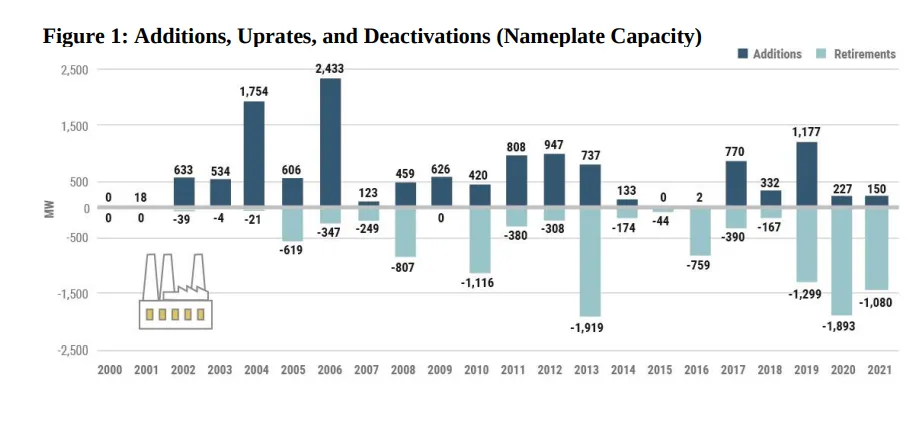New York’s generation resource base and reliability margins have been shrinking for the past few years, complicating the state’s plan to eliminate fossil fuel generators and slash greenhouse gas emissions, according to the New York Independent System Operator.
In some parts of the state, electric system margins “are already close to minimum reliability requirements” the ISO warned in July 1 comments with the New York Climate Action Council, or CAC, which is developing a plan to meet the state’s decarbonization targets.
Utilities, consumer and conservation groups, and local governments also weighed in on the CAC’s draft scoping plan. They called for improving the energy efficiency of the electric grid, moving cautiously to overhaul the generation mix, adding storage and renewables, and mitigating price impacts on consumers.
The draft scoping plan includes scenarios and policy recommendations for New York to meet the requirements of the state’s 2019 climate law, the Climate Leadership and Community Protection Act, or CLCPA. The more than 300-page draft plan drew thousands of comments, and led the CAC in June to extend the comment deadline almost a month to July 1.
Comments from the state’s grid operator and electric utilities show support for CLCPA’s goals, but also concern for how New York will achieve them. The state is targeting 70% renewable energy by 2030, and a zero-emission power sector by 2040.
ISO warns on reliability, backs Clean Dispatch Credit
The ISO warned the CAC that resource retirements have begun to outpace additions, “notably over the last three years.”
“While the state’s bulk electric system meets current reliability requirements, risks to reliability and system resilience remain,” the grid operator said. “A sufficient fleet of new generation resources that satisfy the CLCPA, with the appropriate reliability attributes, must be available before the existing, traditional generators retire voluntarily or are forced out of service.”

The ISO said it “strongly encourages” the state’s Department of Environmental Conservation and other state agencies to “pursue new or amended regulations to implement emissions reductions in an orderly, predictable manner,” with a process that allows for stakeholder comment before a formal proposal is issued.
In June, the ISO issued its Power Trends 2022 report, showing the New York grid’s 2022-23 installed reserve margin at 19.6%, a decrease over the prior year level of 20.7%. Looking out to a carbon-free electric system in 2040, the ISO also concluded that 10% of New York generation will need to come from resources that “are not commercially available at this time.”
The grid operator told the CAC that it also supports considering how wholesale markets can encourage renewable energy generation, potentially through a Clean Dispatch Credit program considered in the draft scoping plan, or a product similar to renewable energy credits, to increase the number of flexible resources interconnecting to the electric grid.
“Such salable attributes could encourage new technologies that run on storable fuels, as opposed to wind or solar energy. Incentives could also encourage storage resources to possess the capability to charge from the grid, regardless of whether they are coupled with generation or load resources,” the ISO said.
Electric utilities weigh in
The state’s largest utilities, including Consolidated Edison, National Grid and New York State Electric and Gas, said the state “will need to use a wide variety of tools” to meet the goals of the CLCPA, and will need to consider changes to how wholesale energy markets are governed.
“High levels of reliability can be supported during the energy transformation but will require thoughtful timing and sequencing of additions of new dispatchable resources and retirement of older conventional resources,” the utilities said in joint comments.
Additional research, development and deployment of non-emitting long-duration storage resources or other emerging technologies “are required to address likely extended periods when there is low availability of intermittent renewable generation,” the utilities said.
Should New York implement a price on carbon, the utilities said the program would need to consider how to maximize its “geographic scope and economic reach” while also protecting vulnerable sectors.
The state’s grid operator has been a proponent of carbon pricing for years, and has said the CLCPA implementation process is one way it could be put in place.
“Revenues from carbon pricing could be used to fund the investments needed to achieve the clean energy transition, improve infrastructure resiliency, and address environmental justice needs,” the utilities said.
Consolidated Edison also filed comments jointly with the Natural Resources Defense Council, urging the CAC “ensure that energy efficiency and end-use electrification are a cornerstone of the state’s strategy.”
“Deeper energy efficiency measures will be needed to help balance the anticipated increases in building and transportation electrification,” the utility and conservation group said.
Consumers worry about cost
New York’s climate goals “will not be achieved if it does not fund them,” New York Public Interest Research Group said in its comments, urging the CAC to identify funding mechanisms that could include a “climate change superfund” to underwrite the transformation.
“The CLCPA transition costs will be orders of magnitude larger than what the state has ever invested, and ratepayers cannot be expected to foot the lion’s share of the bills for a problem they are not responsible for creating,” NYPIRG said.
NYPIRG also called for the state to be more aggressive in pushing for a transition to electric vehicles, “building out charging infrastructure, and supporting early purchases of electric buses.”
In 2020, the state’s Public Service Commission authorized investor-owned utilities to collect up to $701 million from customers to fund a new electric vehicle infrastructure program focused on public charging for light-duty vehicles. Customer and conservation groups are now calling for a similar focus on medium- and heavy-duty electric vehicles.
The Niagara County Legislature also filed comments focused on cost concerns.
“The inherent problem with the draft scoping plan is that New York State does not exist in a vacuum, and while undoubtedly steps need to be taken to address climate change, the unilateral action proposed in this document will produce substantial economic hardship on families and businesses in New York,” the county’s legislature said.






















